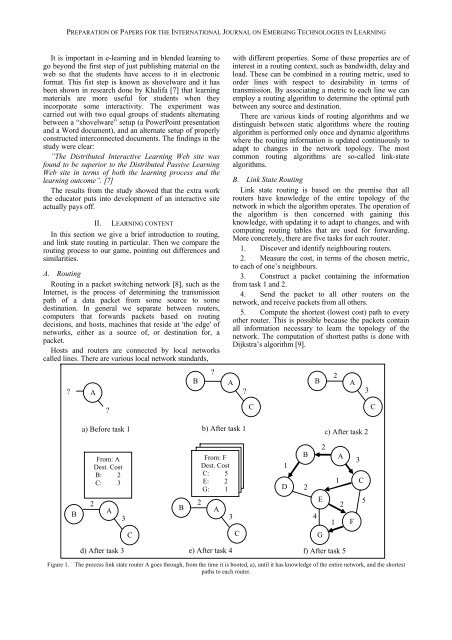A computer game modelling routing in computer networks as ...
A computer game modelling routing in computer networks as ...
A computer game modelling routing in computer networks as ...
You also want an ePaper? Increase the reach of your titles
YUMPU automatically turns print PDFs into web optimized ePapers that Google loves.
PREPARATION OF PAPERS FOR THE INTERNATIONAL JOURNAL ON EMERGING TECHNOLOGIES IN LEARNING<br />
It is important <strong>in</strong> e-learn<strong>in</strong>g and <strong>in</strong> blended learn<strong>in</strong>g to<br />
go beyond the first step of just publish<strong>in</strong>g material on the<br />
web so that the students have access to it <strong>in</strong> electronic<br />
format. This fist step is known <strong>as</strong> shovelware and it h<strong>as</strong><br />
been shown <strong>in</strong> research done by Khalifa [7] that learn<strong>in</strong>g<br />
materials are more useful for students when they<br />
<strong>in</strong>corporate some <strong>in</strong>teractivity. The experiment w<strong>as</strong><br />
carried out with two equal groups of students alternat<strong>in</strong>g<br />
between a “shovelware” setup (a PowerPo<strong>in</strong>t presentation<br />
and a Word document), and an alternate setup of properly<br />
constructed <strong>in</strong>terconnected documents. The f<strong>in</strong>d<strong>in</strong>gs <strong>in</strong> the<br />
study were clear:<br />
”The Distributed Interactive Learn<strong>in</strong>g Web site w<strong>as</strong><br />
found to be superior to the Distributed P<strong>as</strong>sive Learn<strong>in</strong>g<br />
Web site <strong>in</strong> terms of both the learn<strong>in</strong>g process and the<br />
learn<strong>in</strong>g outcome”. [7]<br />
The results from the study showed that the extra work<br />
the educator puts <strong>in</strong>to development of an <strong>in</strong>teractive site<br />
actually pays off.<br />
II. LEARNING CONTENT<br />
In this section we give a brief <strong>in</strong>troduction to <strong>rout<strong>in</strong>g</strong>,<br />
and l<strong>in</strong>k state <strong>rout<strong>in</strong>g</strong> <strong>in</strong> particular. Then we compare the<br />
<strong>rout<strong>in</strong>g</strong> process to our <strong>game</strong>, po<strong>in</strong>t<strong>in</strong>g out differences and<br />
similarities.<br />
A. Rout<strong>in</strong>g<br />
Rout<strong>in</strong>g <strong>in</strong> a packet switch<strong>in</strong>g network [8], such <strong>as</strong> the<br />
Internet, is the process of determ<strong>in</strong><strong>in</strong>g the transmission<br />
path of a data packet from some source to some<br />
dest<strong>in</strong>ation. In general we separate between routers,<br />
<strong>computer</strong>s that forwards packets b<strong>as</strong>ed on <strong>rout<strong>in</strong>g</strong><br />
decisions, and hosts, mach<strong>in</strong>es that reside at 'the edge' of<br />
<strong>networks</strong>, either <strong>as</strong> a source of, or dest<strong>in</strong>ation for, a<br />
packet.<br />
Hosts and routers are connected by local <strong>networks</strong><br />
called l<strong>in</strong>es. There are various local network standards,<br />
with different properties. Some of these properties are of<br />
<strong>in</strong>terest <strong>in</strong> a <strong>rout<strong>in</strong>g</strong> context, such <strong>as</strong> bandwidth, delay and<br />
load. These can be comb<strong>in</strong>ed <strong>in</strong> a <strong>rout<strong>in</strong>g</strong> metric, used to<br />
order l<strong>in</strong>es with respect to desirability <strong>in</strong> terms of<br />
transmission. By <strong>as</strong>sociat<strong>in</strong>g a metric to each l<strong>in</strong>e we can<br />
employ a <strong>rout<strong>in</strong>g</strong> algorithm to determ<strong>in</strong>e the optimal path<br />
between any source and dest<strong>in</strong>ation.<br />
There are various k<strong>in</strong>ds of <strong>rout<strong>in</strong>g</strong> algorithms and we<br />
dist<strong>in</strong>guish between static algorithms where the <strong>rout<strong>in</strong>g</strong><br />
algorithm is performed only once and dynamic algorithms<br />
where the <strong>rout<strong>in</strong>g</strong> <strong>in</strong>formation is updated cont<strong>in</strong>uously to<br />
adapt to changes <strong>in</strong> the network topology. The most<br />
common <strong>rout<strong>in</strong>g</strong> algorithms are so-called l<strong>in</strong>k-state<br />
algorithms.<br />
B. L<strong>in</strong>k State Rout<strong>in</strong>g<br />
L<strong>in</strong>k state <strong>rout<strong>in</strong>g</strong> is b<strong>as</strong>ed on the premise that all<br />
routers have knowledge of the entire topology of the<br />
network <strong>in</strong> which the algorithm operates. The operation of<br />
the algorithm is then concerned with ga<strong>in</strong><strong>in</strong>g this<br />
knowledge, with updat<strong>in</strong>g it to adapt to changes, and with<br />
comput<strong>in</strong>g <strong>rout<strong>in</strong>g</strong> tables that are used for forward<strong>in</strong>g.<br />
More concretely, there are five t<strong>as</strong>ks for each router.<br />
1. Discover and identify neighbour<strong>in</strong>g routers.<br />
2. Me<strong>as</strong>ure the cost, <strong>in</strong> terms of the chosen metric,<br />
to each of one’s neighbours.<br />
3. Construct a packet conta<strong>in</strong><strong>in</strong>g the <strong>in</strong>formation<br />
from t<strong>as</strong>k 1 and 2.<br />
4. Send the packet to all other routers on the<br />
network, and receive packets from all others.<br />
5. Compute the shortest (lowest cost) path to every<br />
other router. This is possible because the packets conta<strong>in</strong><br />
all <strong>in</strong>formation necessary to learn the topology of the<br />
network. The computation of shortest paths is done with<br />
Dijkstra’s algorithm [9].<br />
?<br />
A<br />
B<br />
?<br />
A<br />
?<br />
B<br />
2<br />
A<br />
3<br />
?<br />
C<br />
C<br />
a) Before t<strong>as</strong>k 1 b) After t<strong>as</strong>k 1<br />
c) After t<strong>as</strong>k 2<br />
B<br />
2<br />
From: A<br />
Dest. Cost<br />
B: 2<br />
C: 3<br />
A<br />
3<br />
B<br />
2<br />
From: F<br />
Dest. Cost<br />
C: 5<br />
E: 2<br />
G: 1<br />
A<br />
3<br />
1<br />
D<br />
B<br />
2<br />
2<br />
E<br />
4<br />
A<br />
1<br />
2<br />
1<br />
3<br />
C<br />
5<br />
F<br />
C<br />
C<br />
G<br />
d) After t<strong>as</strong>k 3 e) After t<strong>as</strong>k 4 f) After t<strong>as</strong>k 5<br />
Figure 1. The process l<strong>in</strong>k state router A goes through, from the time it is booted, a), until it h<strong>as</strong> knowledge of the entire network, and the shortest<br />
paths to each router.
















